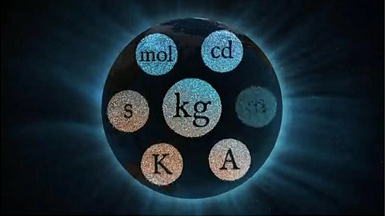



The kilogram, kg, ampere, A, kelvin, K, and mole, mol, will have new definitions, but they will be so chosen that at the moment of change the magnitudes of the new units will be indistinguishable from those of the old units. The new definitions are expected to be approved by the 26th General Conference of Weights and Measures (CGPM) in November 2018 and to come into force on 20 May 2019.
In 1832, Gauss strongly promoted the application of this metric system, together with the second defined in astronomy, as a coherent system of units for the physical sciences. Gauss was the first to make absolute measurements of the Earth's magnetic field in terms of a decimal system based on the three mechanical units millimetre, gram, and second for, respectively, the quantities length, mass, and time. In later years, Gauss and Weber extended these measurements to include electrical phenomena.
At its 25th meeting (November 2014) the CGPM adopted a Resolution on the future revision of the International System of Units. This Resolution built on the CGPM's previous Resolution (2011), which took note of the CIPM's intention to propose a revision of the SI and set out a detailed roadmap towards the future changes.
In the revised SI four of the SI base units ¨C namely the kilogram, the ampere, the kelvin and the mole ¨C will be redefined in terms of constants; the new definitions will be based on fixed numerical values of the Planck constant (h), the elementary charge (e), the Boltzmann constant (kB), and the Avogadro constant (NA), respectively. Further, the definitions of all seven base units of the SI will also be uniformly expressed using the explicit-constant formulation, and specific mises en pratique will be drawn up to explain the realization of the definitions of each of the base units in a practical way.
Defining the kilogram in terms of fundamental physical constants will ensure its long-term stability, and hence its reliability, which is at present in doubt. The new definitions of the ampere and kelvin will significantly improve the accuracy with which electrical and radiometric temperature measurements can be made. The impact on electrical measurements will be immediate: the most precise electrical measurements are already made using the Josephson and quantum Hall effects, and fixing the numerical values of the Planck constant h and the elementary electrical charge e in the new definitions of the units will lead to exact numerical values for the Josephson and von Klitzing constants. This will eliminate the current need to use conventional electrical units rather than SI units to express the results of electrical measurements (see A14). The conversion factor between measured radiance and thermodynamic temperature (the Stefan-Boltzmann constant) will be exact using the new definitions of the kelvin and kilogram, leading to improved temperature metrology as technology improves. The revised definition of the mole is simpler than the current definition, and it will help users of the SI to better understand the nature of the quantity "amount of substance" and its unit, the mole. All in all, the Revised SI will be a better fit to the technology of this century.